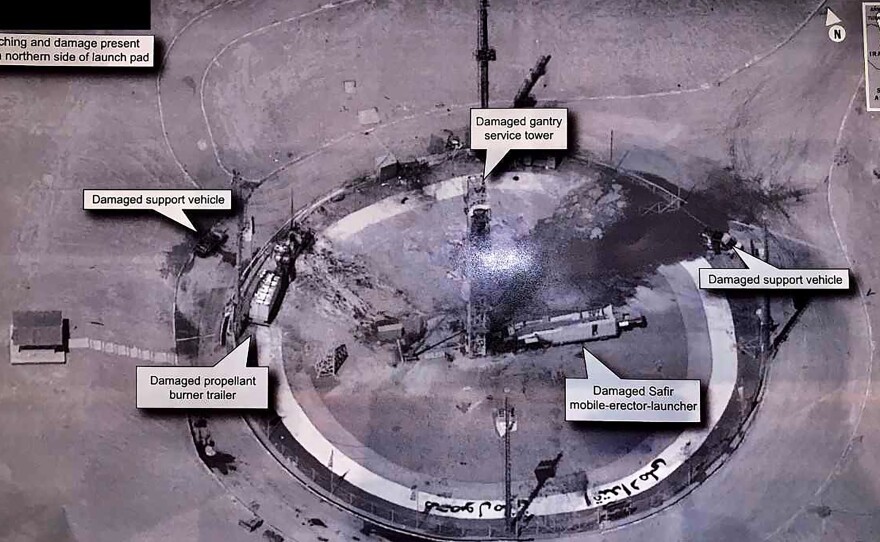The first thing Melissa Hanham did when she saw President Trump's tweet last week was take a screen grab.
"My reaction was to immediately save the image to my phone just in case it got taken down," she says.
The wording on the tweet was cryptic: "The United States of America was not involved in the catastrophic accident during final launch preparations for the Safir [space launch vehicle] Launch at Semnan Launch Site One in Iran," the president said. "I wish Iran best wishes and good luck in determining what happened at Site One."
But it was the photo that left Hanham, a satellite imagery expert, gobsmacked. The day before, on Aug. 29, a rocket had exploded at the Imam Khomeini Space Center in northern Iran. Trump's tweet contained an incredibly sharp image of the aftermath. Visible were burned-out vehicles and lettering around the edge of the pad that couldn't be seen clearly in commercial satellite photos.
Hanham, deputy director of the Open Nuclear Network in Vienna, says she has seen lots of images over the years but never anything like this. "It was so crystal clear and high-resolution that I did not believe it could have come from a satellite," she says.
There are still few details about how the image made its way to Trump's Twitter account. The president received his daily intelligence briefing at 11:30 a.m. ET, about two hours before the tweet.
CNBC reported that Trump was shown the photo during the briefing. A flash visible in the center of the image suggests Trump or someone else took a photo of the original image — which Hanham says might have been the intelligence briefing slide. The Office of the Director of National Intelligence referred questions about the image to the White House.
"We had a photo and I released it, which I have the absolute right to do," Trump told reporters late Friday.
Such a disclosure of classified information by anyone but the president would end in jail time, says Bruce Klingner, a former CIA officer now at the conservative Heritage Foundation.
"Anyone else who revealed it would be sitting in Leavenworth prison, serving out a prison term," Klingner says.
But in the world of classified secrets, the president of the United States has absolute power. "The classification system for national security information is not based in a law, it derives from the president's own status as commander in chief of the armed forces," says Steven Aftergood, who studies government secrecy at the Federation of American Scientists.
The rules about classification are laid out in very detailed presidential orders as part of a system run by the executive branch, and Trump is the boss.
"He therefore has the authority to decide unilaterally what will be disclosed, what will be declassified and what will not," Aftergood says.
Past presidents have used this power sparingly. President Bill Clinton authorized the release of some satellite images during the Balkans conflict in the 1990s. In 2003, Secretary of State Colin Powell used satellite photos in his speech at the U.N. to build a case for war with Iraq.
But Aftergood thinks the images in those instances were deliberately blurred to hide what U.S. satellites could really do. There's a good reason for that: "These satellites are in the billion-to-multibillion-dollar range; they are worth more than their weight in gold," he says. The photos they produce are so good, they're at the limits of the laws of physics — it's the best picture you can possibly take from space. Aftergood thinks the president's decision to tweet what looks like an unblurred photo of the Iranian accident was a bad idea.
"In chess terms, he has sacrificed a bishop for a pawn or less," he says.
"What the president did is pretty sporty," says Rebeccah Heinrichs with the conservative Hudson Institute. But she also thinks it was done deliberately. The text of the tweet was clearly written by or vetted by someone with an intelligence background, Heinrichs says, noting the use of abbreviations such as SLV for "space launch vehicle." And she thinks the tweet sends a powerful message to Iran.
"He is communicating that we are carefully watching and that we are using restraint, and that if we wanted to do more, we could," she says.
At least some experts agree. "Nations are not suddenly going to say, 'Oh no, we had no idea they could watch us this closely!' " says one senior satellite imaging expert who asked to remain anonymous because of the furor around Trump's tweet. "Yes, there is clearly more detail, but not a whole lot of useful information beyond what the best commercial imagery provides."
But Aftergood thinks Iran will be able to learn from the image. A group of independent satellite spotters says it has already determined which U.S. satellite took the picture. USA 224, one of America's most advanced spy satellites, passed over the launch site shortly after the accident.
Now that the satellite has been pinpointed, Aftergood worries that Iran can evade it. For example, he says, in the runup to an Indian nuclear weapons test in 1998, India tracked U.S. satellites and made sure not to move any major equipment while they were overhead. The U.S. intelligence community was caught off guard by the test when it happened.
And Klingner, the former CIA officer, notes that Iran wasn't the only one that saw the tweet.
"Our adversaries — Russia, China, North Korea, Iran, Syria and others — will be looking at this, trying to figure out how good our capabilities are," Klingner says. He worries they just might learn something.
Copyright 2019 NPR. To see more, visit https://www.npr.org.






